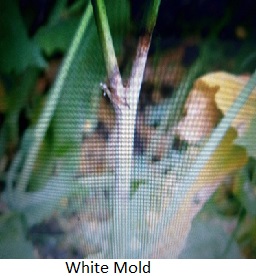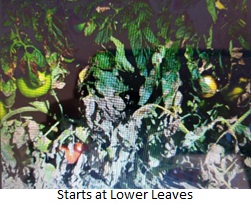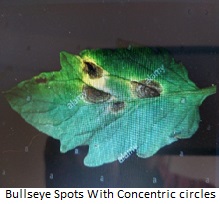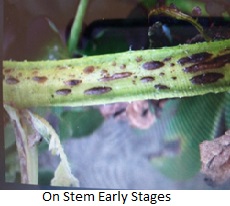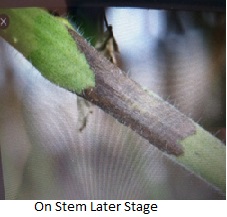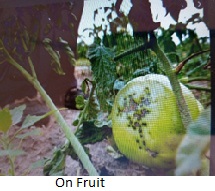Septoria
Conducive conditions for this are temperatures of 20-25⁰ C and high humidity/dew.
Septoria leaf spots start off somewhat circular and first appear on the undersides of older leaves, at the lower part of the plant. They are small, 1.6 to 3.2 mm, initially yellow, later turning dark brown margin and lighter gray or tan centre; some yellowing of the surrounding may take place. Spots merge together to larger spots or blotches. Symptoms of this disease usually first appear after fruit start to ripen. In the fungus spot dark brown pimple like fruiting bodies are formed. Although the symptoms usually occur in the older, lower leaves, the disease can develop at any stage in the tomato plant's life. They may also appear on the stems as well as the flowers, but rarely affect the fruits.
If untreated, Septoria leaf spot will cause the leaves to turn yellow and eventually to dry out and fall off. Septoria leaf spot spreads rapidly.
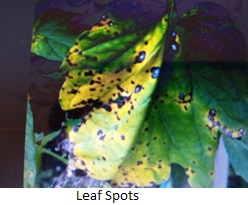
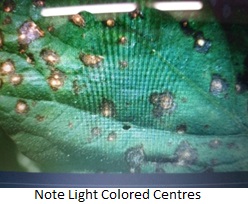
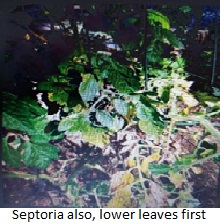
Athracnose (Colletotrichum)
The disease develops in wet conditions at temperatures of 20-24⁰C (free water, water splashing!). On leaves, anthracnose generally appears first as small, irregular yellow or brown spots. These spots darken as they age and may also expand, covering the leaves.
On the underside of infected leaves fruiting structures of the fungus are formed protruding like pimples, especially along the leaf veins.
Infections on green fruit are rare. Symptoms on ripe fruit are small, sunken, circular spots that may increase in size up to 0.5 inch in diameter. The centres of older spots later become blackish.
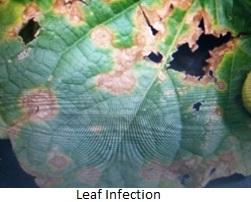
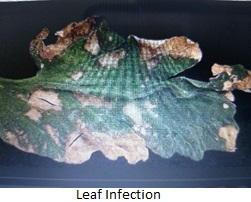
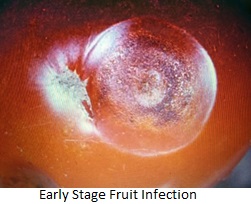
Late blight (Phytophtora)
Late blight occurs at temperatures of 18-24⁰C, in conditions of high humidity, rain, fog or dew. Infection mostly takes place well after flowering has started and the lower leaves are first affected. First lesions are small and appear as dark, water-soaked, greasy-looking, grey-green spots. These irregular leaf spots will quickly enlarge and a white mold (especially in wet weather) will appear on the margins of the affected area on the underside of leaves. White mold may also be found on the underside of the leaves.
The leaf spots eventually become dry and papery. Blackened areas may also appear on the stems.Complete defoliation (browning and shrivelling of leaves and stems) can occur within two weeks from the first symptoms.
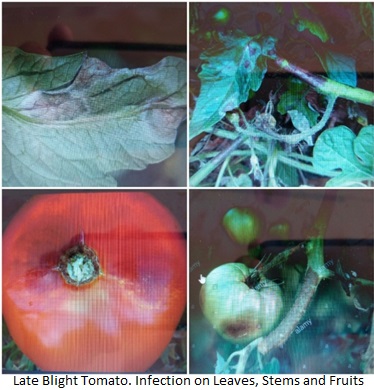
Fusarium wilt (Fusariumoxisporum)
This shows up sometimes as some vein clearing in the upper leaves like a magnesium deficiency; yellowed tissue becomes necrotic. Irregular shaped, water-soaked blotches may appear, starting on the upper leaves. Sometimes white spores are found under the leaves.
Wilting starts often with a single leaf or shoot, near the top of the plant. This will recover at night when temperatures are cooler, but as the disease progresses, the entire plant wilts and will not recover. Lower leaves turn yellow, often starting on only one side. As with the wilting, the yellowing will gradually move up the plant. Stems discolour. Vascular turns brown. Dark brown streaks form lengthwise on the stem.
F. Solani
F. solani often produces black spots on the tap root. Dark brown, sunken wounds are formed at the basis of the stem, at scars on leaves and wounds where pruning was done. Later shoot development from cured wounds also show lesions. Wilting occurs at high temperatures and overall growth is stunted.
Fruits have pale, longitudinal brown stripes and become flat on the top. Flower and early fruit rot occurs. Hygiene and careful crop handling is necessary (avoiding wounds).
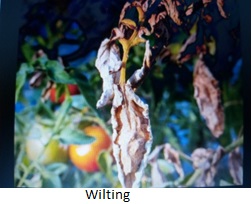
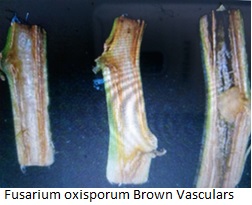
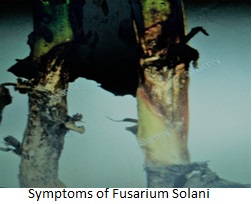
Bacterial Wilt (Ralstonia)
This starts with single leaves wilting and turning yellow, then more leaves follow; stems stand straight. Younger leaves loose turgor on hot days. Wilting of the whole plant may take place rapidly or stunting occurs and many adventitious roots are formed. Stem will ooze cream colored bacterial slime from fresh cut. Vascular tissue turns brown. Rotate crop with ladies fingers to contain the disease.
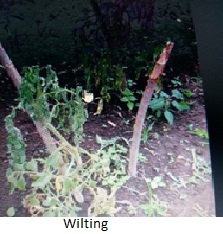
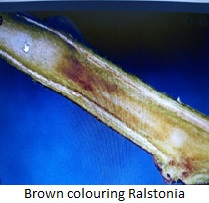
Downy Mildew
Downy mildew often appears first on the underside of the leaves, as a bluish tinge. On the foliage, small yellow spots develop on the upper sides of the leaf while white to bluish-white fluffy growth forms on the underside of the leaf.
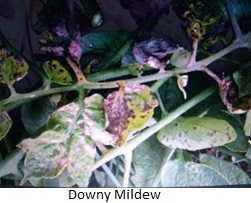
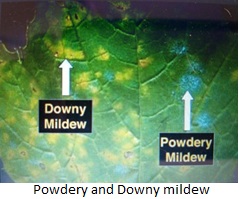
Leaf Mold (Passalora)
Individual greyish spots (easy to confuse with Downy Mildew) appear on the leaf.
Cercospora
Disease appears as circular spots up to 1 cm in diameter with a tan or grey centre of 0.5-1mm and a yellow halo. It resembles a frog-eye. The spots merge and finally there is early leaf drop.
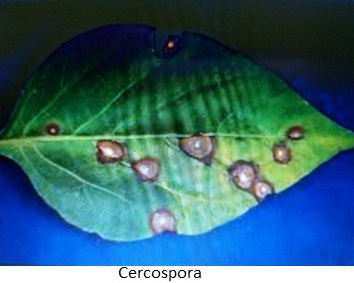
Bacterial Spots (Pseudomonas and Xanthosoma)
Numerous small, angular to irregular, water-soaked spots appear on the leaves. On fruits it appears as slightly raised to scabby spots. The leaf spots may have a yellow halo. The centres dry out and frequently tear. Affected leaves turn brown but do not drop.
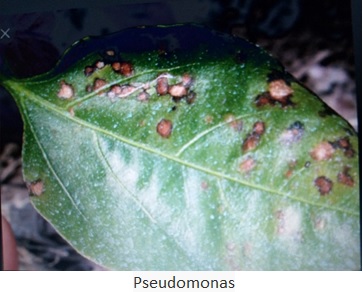
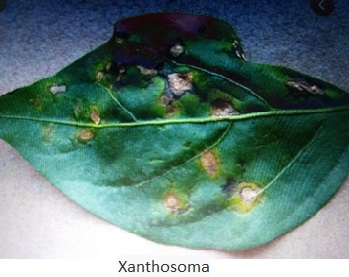
Southern blight (Sclerotiumrolfsii, Atheliarolfsii)
On tomato and pepper, the most common symptom occurs on the lower stem where a brown to black lesion usually develops on the stem near the soil line. The lesion will develop rapidly and can completely girdle the stem, which will cause a sudden and permanent wilt of all the above parts. Young plants may fall over at the soil line. Under moist conditions, white mycelium will develop on stem lesions and can sometimes extend several centimeters up the stem. After a few days, tan to reddish-brown, spherical sclerotia (1 to 2 mm in diameter) can appear on the mycelia.
The fungus can easily infect fruit in contact with infested soil. Lesions will initially appear as sunken and slightly yellow areas that later become water-soaked, soft, and star-shaped spots. The fruit will collapse within 3 to 4 days and white mycelium can fill the lesion cavity.
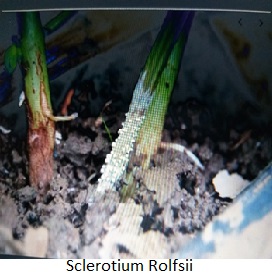
White Mold
This affects any of the branches on the plant. It can be identified by darkening of the affected branch followed by a white powdery cover.
